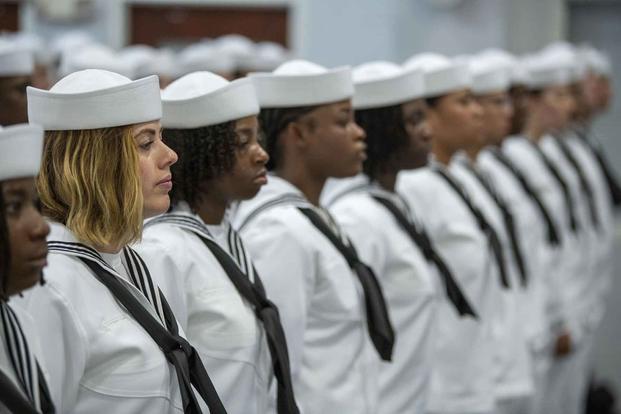The Navy said Thursday it will meet its annual recruiting goals after struggling for years to get enough people to join the ranks.
Rear Adm. Jim Waters, who oversees the Navy’s recruiting command, told reporters that the service projects it will have 40,600 recruits by the end of September. Waters attributed the success to the hard work of recruiters but as well as changes behind the scenes that made the process smoother for recruits and gave leaders greater insight into how the Navy’s recruiting efforts are going.
“I am very proud to announce that the Navy has had its best stretch of recruiting results since 2020,” Waters told reporters.
Read Next: Army Says Arlington National Cemetery Employee Being ‘Unfairly Attacked’ by Trump Campaign
At the moment, the sea service has contracted 36,776 future active-duty sailors and shipped 30,314 to boot camp. Waters said that his recruiters were averaging more than 4,000 contracts per month.
He chalked up a large portion of that success to changes within the recruiter community that included staffing the command close to 100% and adding goals that incentivize overproduction of recruits.
Rear Adm. Jeffrey Czerewko, head of the Navy’s Training and Education Command, also noted that improving and strengthening the service’s ability to track and monitor its recruiting efforts have also been key to the service’s success.
Czerewko said that, as late as last summer, “we never knew if we were winning or losing day to day until the end of the month,” whereas now they are able “to know if we were winning or losing every day.”
This close tracking also meant that leaders were able to move faster to clear interested applicants through the medical screening process when, in years past, recruits would get snarled in monthslong efforts to either explain minor health issues or try and get waivers to allow them to serve anyway.
“We have rejuvenated our medical waiver process and eliminated all backlog,” Waters said, noting that he and his team are now “making medical waiver decisions in zero to three days, most at one day.”
The good news comes after years of efforts by the Navy, as well as other services, to fix lagging recruiting numbers that, at least in some part, military officials attributed to the COVID-19 pandemic.
In addition to trying the conventional ideas of offering eye-watering enlistment bonuses and spending millions on high-profile advertisements at events like the Super Bowl, the Navy also dedicated some of its efforts to tweaking policies to increase the percentage of the U.S. public it considered eligible.
It started offering exceptions over tattoos, single parent status, and positive drug and alcohol tests.
Last winter, the Navy even raised the maximum enlistment age to 41 and loosened entry exam rules to allow the lowest-performing academic category of applicant to join the service.
It teamed those efforts with pre-boot camp schools that would either have recruits work out in order to boost their physical fitness scores or take academic courses to raise test results.
Czerewko said that, while courses like that are “a friction inducer,” their outcomes have been impressive.
“To watch young men and women … their world has changed completely,” Czerewko said, adding that he’s seen recruits go from having around 12 job choices in the Navy to being qualified for highly technical and prestigious jobs like information technician.
“It’s incredible,” he said.
As a result of this glut of new recruits, Czerewko now faces a different problem — a shortage of sailors to train the new candidates at boot camp.
Czerewko said that, while he is on a path to get the Navy’s boot camp at Great Lakes, Illinois, to 90% manned over the next year, he’s had to slow the flow of recruits in the meantime.
“We weren’t going to break humans to make sailors,” Czerewko explained. He also said he’s actively keeping an eye on the quality of life of the sailors who train recruits at Great Lakes.
Related: No Diploma? No Problem! Navy Again Lowers Requirements as it Struggles to Meet Recruitment Goals
Story Continues
Read the full article here


